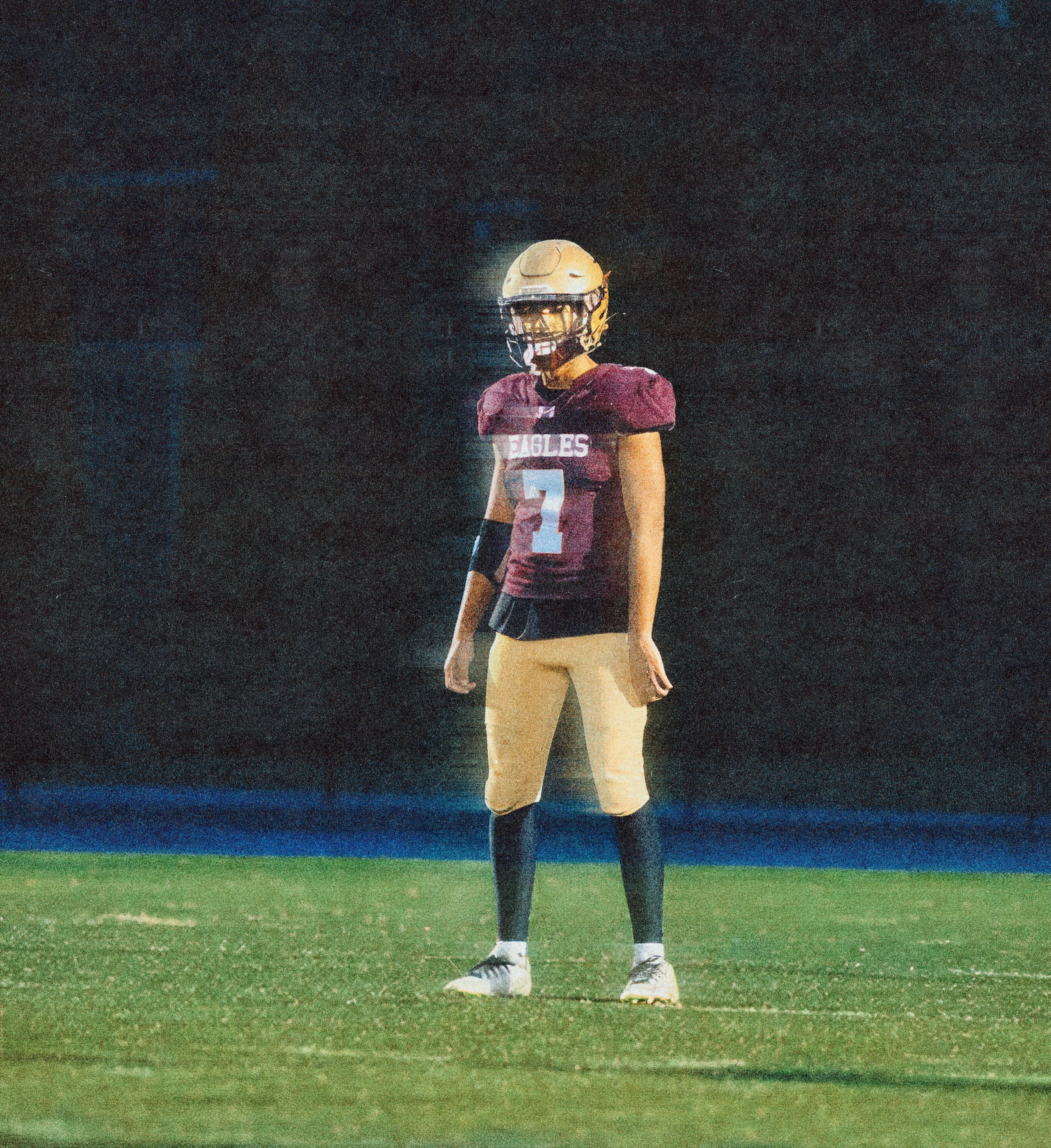Could This High School Football Tragedy Have Been Prevented?
When Sharon sophomore Rohan Shukla suffered a devastating brain injury during a Thanksgiving game, the small Massachusetts town had to confront a difficult question: How can we get the balance of sports culture and student safety right?

Illustration by Benjamen Purvis / Photo illustration by Benjamen Purvis
Slate-gray clouds and the threat of rain loomed over Sharon High School’s football field on Thanksgiving Day last fall, yet hundreds of students and their families surged through the gates for a matchup between the hometown Eagles and the Oliver Ames High School Tigers from Easton, who had a 5–5 record heading into the final game of the year. Though Sharon was winless that season, the players were fired up, hungering for their first taste of victory.
The stands buzzed with energy—former classmates reuniting, fans rooting for their schools, and cheerleaders hyping up the crowd. With mere minutes remaining in the first half, Sharon safety Rohan Shukla took what looked like a routine hit. The 5-foot-11, 150-pound sophomore staggered to the sidelines under his own power, seeming to walk it off. Then, in an instant, he crumpled to the ground.
The crowd fell silent as medical staff rushed toward the fallen player. Oliver Ames’s 21–0 lead became meaningless as officials called off the game. Medics loaded Rohan into an ambulance, rushing him first to Good Samaritan Hospital in Brockton, then to Mass General, where doctors diagnosed a subdural hematoma—blood pooling dangerously between his skull and brain. Surgeons worked swiftly to control the bleeding, yet despite an emergency operation, the 15-year-old slipped into a coma.
For a month, his family and friends waited anxiously for any sign of improvement. Finally, there was hope as Rohan slowly began to regain consciousness. Thirty-five days after his injury, he was moved to Spaulding Rehabilitation Hospital, where doctors have cautioned that Rohan’s recovery will will be a long one.
Like any parent, I followed Rohan’s story with dismay, but it also struck a nerve: Ten years ago, I wrote an article for this magazine about whether I should let my then-eight-year-old son, Finn, play football. At the time, concussions were at the forefront of everyone’s minds. Nearly every day, it seemed, a story about the dangers of brain injury made headlines. This was back when researchers had just started acknowledging that young, developing brains are actually more vulnerable to injury and that the effects of many minor hits throughout a season could be more damaging than head injuries in older players. In response, youth football enrollment dropped nationwide; between 2016 and 2023, tackle football participation rates declined 29 percent for kids ages 6 to 12.
When Finn came home from school one day, begging me to let him play football, I felt torn—and determined to educate myself before I made a decision. I read everything I could on the subject, spoke with concussion experts, and even met with the football coaches at our local MetroWest high school, who served up a convincing football-will-change-your-life pep talk. They painted a picture of how it could transform my son, building his confidence and forging lasting friendships. Then one coach delivered the clincher: “Football carries with it an intangible coolness.”
But was all that worth the potential risk of head injury? Not convinced, my husband and I decided to punt the decision down the road: We told Finn that if he still wanted to play when he got to high school, we’d revisit the topic then. Thankfully, we never had to make that decision. As we’d secretly hoped, Finn lost interest in football and instead swam competitively in high school (a blessedly non-contact sport). But it easily could have gone the other way.
And so Rohan’s Thanksgiving Day injury struck a deep chord—and not just with me, but with thousands of others. A team captain launched a GoFundMe campaign to give Rohan the “best chance for recovery…in a sport he loves the most,” which has since raised $89,000. The Sharon community and beyond rallied around the family, offering prayers, meals, and support to Rohan, his parents, and his twin brother.
That’s when I learned something that hadn’t made the news: Rohan had reportedly sustained a concussion earlier in the season and had just been cleared to play in the Thanksgiving Day game. This detail hit me like a Mack truck. As I probed deeper, uncovering facts about Rohan’s accident, one question haunted me: Could this tragedy have been prevented?

Sharon High School sophomore Rohan Shukla was hospitalized after suffering a brain injury during a Thanksgiving Day football game. / Photo via GoFundMe
To fully understand what happened at the Thanksgiving Day game, we have to start with a controversial 2010 decision by the Massachusetts Interscholastic Athletic Association (MIAA). The organization split the state’s southeastern Hockomock athletic league into two parts: the Davenport division for the five smaller schools (Sharon, Foxborough, Canton, Stoughton, and Oliver Ames in Easton) and the Kelley-Rex division for the five larger schools (Mansfield, Attleboro, North Attleboro, Franklin, and King Philip in Wrentham), though two years later, the distribution shifted slightly and two new schools joined the league. Some locals were upset by the decision, accusing the league of having gone soft in an attempt to create more winners and bring in more revenue—but ultimately, the split held. The consolation was that the league would realign the divisions, based on grades 9 through 11 enrollments, at a meeting of principals and athletic directors every few years.
However, in 2022, the MIAA introduced a new “competitive equity” formula for division alignment. This change was part of a broader movement by superintendents, athletic directors, and state sports association leaders across the country to address competitive imbalances in school athletics. Their concern was simple: Students at better-funded schools had significant advantages over those with fewer resources. The new formula went beyond enrollment numbers, examining factors including stability (how many kids move in and out of the district) and high-needs populations. It looked at the percentage of English-language learners, special education students, and economically disadvantaged students—recognizing that not every family could afford after-school sports or expensive club teams for skill development. In theory (and hopefully practice), this would help level the playing field and reduce movement between divisions.
As a result, at the biannual realignment meeting in late 2023, it was decided that the Sharon Eagles (who had just returned to the division after playing independently, with some success, in 2021 and 2022) would move to the Kelley-Rex division with the larger schools for the fall 2024 season. They’d now be competing against Franklin, King Philip, Attleboro, Taunton, and Milford high schools. To understand the significance of this move, consider that Sharon (enrollment 1,161) hadn’t played the city of Taunton (enrollment 2,877) since 2012. Suddenly, Sharon had been thrust into the big leagues, and some parents weren’t thrilled.
Neither were some of the players, for two reasons: They’d be moving divisions while also adjusting to a new coach. Longtime Sharon football coach Dave Morse had resigned at the end of the 2023 season, replaced by Ben Shuffain, a 1999 Sharon grad who was coming off a winning season as head coach for Carver’s high school team. Worried that they’d be crushed by schools with significantly more robust football programs, a handful of Sharon players quit the team. Their fears weren’t unfounded—Sharon’s 2024 roster had just 48 players, compared to Attleboro’s 81. Rohan was among a dozen sophomores who decided to stick it out for the season.
Now, as any longtime South Shore resident might tell you, the town of Sharon isn’t exactly known for its football. In 2012, when Sharon High pulled off a surprise upset by winning the MIAA Division III Super Bowl, sports journalist and 1998 Sharon grad Rich Levine called it a “Cinderella” story, made all the more impressive by the fact that “for the last 20-plus years, Sharon High School has been one of the worst football teams in the state,” he wrote in a column on NBC Sports Boston. “It became a part of our identity.” Levine lightheartedly blamed the preponderance of Jewish moms in town: “Football and Jewish mothers have a longstanding rivalry that I believe dates back to the Stone Ages,” he wrote. “The fact that a significant portion of the player pool simply wasn’t allowed to play limited the team’s potential and always wreaked havoc on the overall depth and numbers.”
Due to dwindling interest, Sharon no longer has a Pop Warner feeder league to introduce tackle football to young players (although a new youth program is in the works for this fall). Elementary- and middle-school-age kids in town who want to play football can join leagues in nearby towns. As a result, most Sharon players don’t learn how to tackle—or be tackled—until ninth grade. Coach Shuffain acknowledged this lack of experience as a potential hurdle in a 2024 Boston Globe season preview, expressing concern with the depth at the high school level.
This raises a crucial question: Is it possible younger players, like Rohan, had to step into starting positions before they were ready?
Is it possible younger players, like Rohan, had to step into starting positions before they were ready?
The Eagles’ fall season was painful from the start. After opening with a 7–42 loss to Marlborough, the team endured a string of embarrassing shutouts: 0–38 against Dover-Sherborn, 0–34 to Westborough, 0–42 versus Attleboro, 0–50 against King Philip, and 0–46 facing Milford. The boys who’d quit the team prior to the season had seen it coming—Sharon was getting creamed by the competition, leaving parents worried. By the time the Thanksgiving Day game against Oliver Ames rolled around, Sharon had dropped 10 straight. “Everybody was like, ‘Somebody’s going to get hurt,’” said one Sharon mom, who, like many parents I spoke to, asked not to be named for fear of reprisal in the community. “The teams were so unbalanced.”
Rohan had reportedly sustained a concussion earlier in the season that required rest and rehabilitation. Under state and MIAA rules, he couldn’t return until he was symptom-free and received medical clearance. The state’s concussion protocol then required a careful progression: light aerobic exercise, followed by sport-specific training, non-contact drills, full-contact practice, and, finally, game play. Athletes can only advance through these stages if they remain symptom-free. This careful approach exists because a second blow to the head before full recovery—even a minor one—can trigger second impact syndrome (SIS), a rare but deadly condition where the brain suddenly swells. According to Massachusetts Medical Society guidance for coaches, SIS can lead to unconsciousness or cardiac arrest within minutes.
Still, there’s one notable flaw in this protocol: It relies largely on self-reporting, which is notoriously unreliable, especially with teens who might just want to play and don’t want to let down their teammates and coaches.
When Rohan suited up for the Thanksgiving Day game against Oliver Ames, he was one of a few players wearing a Guardian Cap, a soft-shell padding that attaches to the exterior of a helmet for added protection. While these caps, invented in 2010, reduce collision impact through their extra layer of padding, they can’t definitively prevent concussions—particularly crucial for Rohan, who may have already been at higher risk for deadly SIS after his earlier concussion. The good news, though, is that so far, the NFL’s experience with Guardian Caps has been promising: After requiring them in 2022 for certain positions during training camp and preseason, the league expanded the mandate to all pre-season and regular season contact practices starting in 2023. Last fall, the league found a 50 percent reduction in concussions among players wearing Guardian Caps during the preseason, and officially allowed players to wear them during games, too.
The NFL also made changes to the kickoff—long considered one of the game’s most dangerous plays. The kicker stands on his own at the 35-yard line while the rest of the coverage team and most of the return team line up between 5 and 10 yards from one another, waiting to move until the ball touches a player or the ground. The goal is to prevent players from running at each other at top speed, thereby reducing the number of high-impact, head-on collisions. A 2018 study of Ivy League football games, published in the medical journal Injury Prevention, showed that kickoffs accounted for 6 percent of all plays but 21 percent of concussions from 2012 to 2018.
It’s concerning that these changes haven’t trickled down to youth football: The majority of high school teams are still wearing old-school helmets and using the traditional kickoff format. That’s despite research from multiple studies, including some at Boston University, showing that “players who start playing tackle football at a young age, sustaining more of those smaller head blows in their teenage years, are more likely to suffer from CTE [chronic traumatic encephalopathy, a degenerative brain disease] and the long-term, lingering effects,” according to an October 2024 story in the Brink, which covers research news at BU. A 2019 study in the journal Annals of Neurology by a team of researchers from the Boston University CTE Center found that the risk of developing CTE increases 30 percent with every year spent playing tackle football.
Mary Beth Miotto, cochair of the Massachusetts Medical Society’s Committee on Student Health and Sports Medicine, believes football-related concussions in youth and young adults are a “public health problem,” and yet “we’re not looking at it in a very systematic way in terms of outcomes and interventions,” she says. We’re also not funding it. The NFL—a multibillion-dollar company—has a committee whose sole task is to review injury data after every season and examine videos to see how injuries occur. A nonprofit organization such as the MIAA likely doesn’t have the bandwidth to take this on. Instead, Miotto says, it needs to happen on a national level—not only collecting the data and analyzing it but also making changes to the game that will help reduce the incidence of serious injuries. Miotto believes the onus is on the NFL to provide access to resources and push down some of the funding for research—and soon. “It’s taking too long,” she says. After all, we now know that concussion issues “don’t just start once they sign an NFL contract.”
In the meantime, some high schools have made it their mission to make the game safer. A league of independent schools in New York City, for instance, eliminated the kickoff and onside kicks altogether and set limits on full-contact practices. Riverdale Country School athletic director John Pizzi, who initiated the rule changes to the New York City league, told the Riverdale Press that he “wanted to change football in America,” and noted to CNN that the new rules led to a 33 percent decrease in concussions between 2019 and 2021. He’s hoping to inspire similar changes in high school athletic conferences nationwide.
Closer to home, at Stoughton High School, there’s a different approach. When the football program equipped every player with a SAFR helmet cover last season—a polyurethane foam cover that fits over existing helmets—head coach Christopher Evans saw striking results. “All I have is anecdotal data,” he told me, “but we did not have a single concussion this season with our players who were wearing the SAFR helmets. Our opponents didn’t change, our style of play didn’t change, and the game of football didn’t change. So you have to really dig in and ask, ‘What was the difference?’” Evans points to the helmets and strong off-season training for the improvement. While the program is still fundraising to cover the equipment costs, he’s convinced it’s worth the investment. “Every decision we make,” he says, “is in the best interest of the kid.”
After talking to the experts, one question still gnawed at me: Why wasn’t there more vocal pushback from Sharon parents, coaches, and administration when they learned they’d be moving to the more competitive Kelley-Rex division? The Eagles had finished fifth out of six teams in the Davenport division in 2023, making it hard to understand what would have compelled, or even justified, the move. When I emailed a representative from the MIAA, asking for more of an explanation, I got no response. That was hardly surprising: Over the past few months, when I tried to talk to parents or players about Rohan’s accident, my phone calls and emails went unanswered. Sharon residents had understandably circled the wagons to protect his family’s privacy.
However, I believe the town’s acquiescence could potentially be traced back to an unlikely source: the Sharon boys’ basketball team’s dominant 2023–2024 season. Last year, the Eagles advanced all the way to the state semifinals, beating Bedford High School and extending what the Boston Globe called the team’s “magical run” to their first appearance in the state finals since 1991. Despite a hard-fought game, the Eagles fell to Malden Catholic, but Sharon got a taste of victory—and residents liked it. “That basketball run was such a big deal to this town,” the Sharon mom told me. The players became local celebrities, greeted by friends and strangers alike. Athletic success was a novelty in Sharon: After all, I was told by way of explanation, “People don’t move here for their kids’ athletic careers.”
Residents and students were still riding that high when football season began in the fall. The basketball team had shown that Sharon could compete with the best of them, and people were excited to see whether the football team would follow in their footsteps. Now, we know the answer is a definitive “no”—the team lost every game, badly, and despite following concussion protocols and wearing a Guardian Cap, Rohan Shukla suffered a nearly fatal injury.
In the aftermath of Rohan’s injury, the response felt strangely muted. Ten years ago, when I first wrote about youth football, parents were fired up—ready to publicly rally together to ban contact sports altogether. Now, the reaction seemed more resigned: Yeah, we know football is dangerous; let’s just move on. In fact, over the past two years, the number of kids playing high school football is on the rise after trending down for a decade, according to a survey by the National Federation of State High School Associations. When I asked Miotto, of the Massachusetts Medical Society, what she thought the difference was, she suggested that perhaps post-pandemic, parents “just got a little amnesia.” After all those months of school shutdowns and social isolation, we desperately wanted our children off their screens and interacting with other kids in real life. I would have signed up my twin boys for anything coming out of the pandemic—even football.
And yet, despite improvements in safety measures and equipment, concerns about head injuries and serious, long-term health consequences persist. There were 16 fatalities among college, high school, middle school, and youth league football players in 2023, 13 of which were directly or indirectly related to football participation, according to the National Center for Catastrophic Sport Injury Research. In August 2024 alone, there were seven deaths from football, for reasons ranging from heat stroke to severe head injury.
There’s no question that Sharon was outsized and outmatched in the Kelly-Rex division.
There’s no question Sharon was outsized and outmatched in the Kelley-Rex division. In its efforts to level the playing field and close the gap between the haves and the have-nots, the MIAA seems to have overcorrected and left Sharon exposed. While the affluent town certainly has the resources to hire experienced coaches and maintain top-tier facilities—and many Sharon families can afford to send their children to training camps and hire private trainers—there was a crucial missing piece: Until this year, Sharon didn’t have enough players to support a youth football program, and the high school roster was so thin that coaches had no choice but to start freshman and sophomores who might otherwise have been on junior varsity.
The MIAA should have anticipated this. The essence of sports and competition lies in the possibility of victory, yet the Eagles stood no chance against the powerhouse teams in their new division.
There’s optimism ahead, though: Sharon coach Ben Shuffain has taken the matter into his own hands, withdrawing the Eagles from the league and scheduling games independently. Next year, Sharon will play schools such as Dighton-Rehoboth (enrollment: 621), Wareham (enrollment: 533), and Martha’s Vineyard (enrollment: 744). When a commentator on Facebook asked, “Not playing a [Hockomock] schedule next year?” Shuffain replied, “We are not. Building the program from the ground up with a youth program and giving our kids a safer and more competitive football experience.”
That’s really all any parent can ask for. We know football is a violent sport—that’s a huge part of the appeal for fans—and freak accidents happen. But we have to trust that coaches and administrators are making decisions with the well-being of our kids as their top priority. Otherwise, we’re just throwing Hail Marys.
This article was first published in the print edition of the May 2025 issue with the headline: “Hail Mary.”
Previously
- Inside the High-Stakes, Zero-Sum Game of Youth Club Sports


